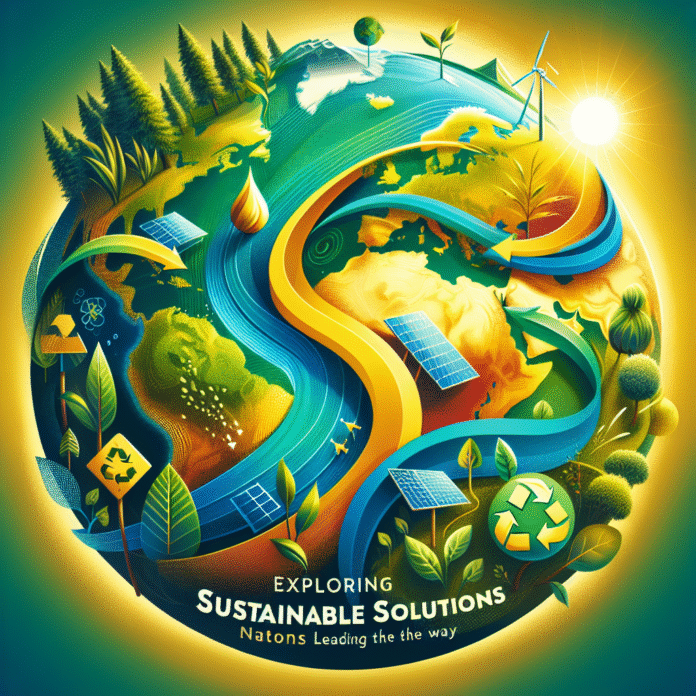As climate change and environmental degradation continue to pose significant threats to our planet, nations around the world are stepping up their efforts to adopt sustainable solutions. From renewable energy initiatives to innovative waste management practices, many countries are setting an example for others to follow. This article explores some of the nations leading the way in sustainability and the strategies they are implementing to create a greener future.
1. Sweden: A Pioneer in Renewable Energy
Sweden is frequently recognized as a global leader in sustainability. The Scandinavian country has committed to becoming the world’s first fossil fuel-free nation by 2045. Sweden generates approximately 54% of its energy from renewable sources, including hydropower, wind, and biomass. The government has implemented various policies, such as carbon taxes and incentives for green technology, to encourage both businesses and individuals to adopt more sustainable practices. Sweden’s effective waste management system, whereby 99% of urban waste is recycled or used for energy, sets a high standard for others to emulate.
2. Germany: The Energiewende Initiative
Germany launched the Energiewende ("energy transition") initiative to shift from fossil fuels to renewable energy sources. The country aims to derive 65% of its electricity from renewables by 2030. Germany’s investments in solar and wind energy are notable; the nation has become a global leader in solar panel production and wind turbine technology. The government supports this transition through subsidies and financial incentives for both households and businesses investing in renewable energy solutions. Germany’s commitment to improving energy efficiency and reducing greenhouse gas emissions showcases a robust approach to sustainability.
3. Denmark: Leading in Wind Energy
Denmark has made remarkable strides in wind energy, with wind turbines now supplying about 47% of the country’s electricity. This commitment to renewables not only helps reduce carbon emissions but also has positioned Denmark as a global hub for wind technology. The Danish government is pursuing ambitious targets, including generating 70% of its greenhouse gas emissions by 2030. Furthermore, Denmark promotes sustainable urban planning, integrating green spaces and cycling infrastructures in its cities to enhance residents’ quality of life while minimizing their carbon footprint.
4. Costa Rica: A Model for Conservation
Costa Rica is renowned for its lush biodiversity and extensive conservation efforts. Nearly 99% of the country’s electricity comes from renewable sources, primarily hydropower. Costa Rica has established a national strategy for reducing deforestation and fostering reforestation, leading to an increase in forest cover from 21% in 1986 to over 50% today. The government’s focus on eco-tourism and sustainable agriculture promotes environmental conservation while supporting local economies. By prioritizing sustainability at a national level, Costa Rica sets a compelling example for environmental stewardship.
5. Bhutan: Measuring Happiness Through Sustainability
Bhutan’s unique approach to sustainability is centered around its commitment to Gross National Happiness (GNH), which measures the country’s success based on the well-being of its citizens and the environment rather than GDP. The government has pledged to maintain its forests, which cover 72% of its land area, and aims to be carbon negative. Conservation practices, renewable energy initiatives, and a focus on organic agriculture reflect Bhutan’s holistic approach to development and sustainability. This balance between tradition, modernity, and ecological integrity positions Bhutan as a global leader in green policies.
6. New Zealand: Balancing Land and Marine Conservation
New Zealand’s commitment to sustainability is encapsulated in its ambitious goals for promoting biodiversity and conserving marine resources. The government has implemented various initiatives to protect both terrestrial and marine ecosystems, with plans to achieve net-zero greenhouse gas emissions by 2050. New Zealand also prioritizes sustainable agricultural practices, recognizing the need to balance food production with environmental preservation. With its breathtaking landscapes and rich biodiversity, the country serves as a living laboratory for sustainable living.
Conclusion
As the world grapples with the implications of climate change and ecological degradation, the need for sustainable solutions has never been more urgent. The nations highlighted in this article exemplify innovative and effective approaches to sustainability, demonstrating that it is possible to meet the needs of the present without compromising the future. By adopting similar strategies, other countries can contribute to a collective global effort toward a sustainable and prosperous world for generations to come. It is a testament to the potential of human ingenuity and cooperation in addressing one of the most pressing challenges of our time.






